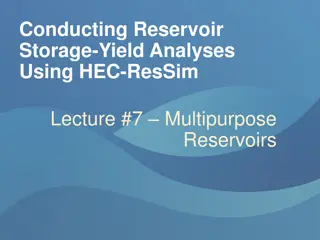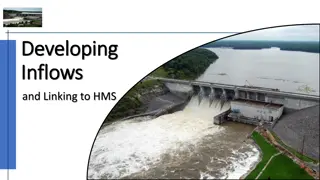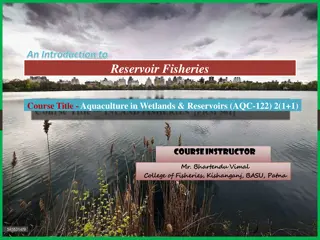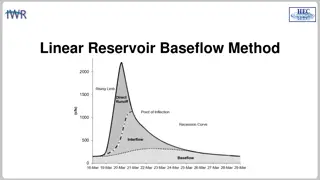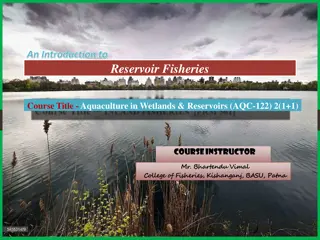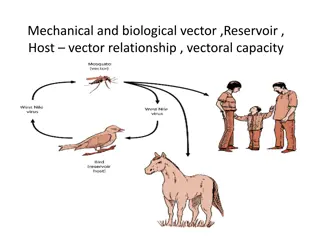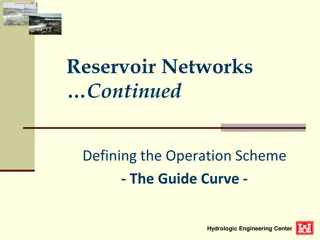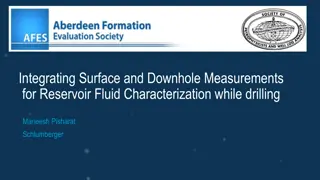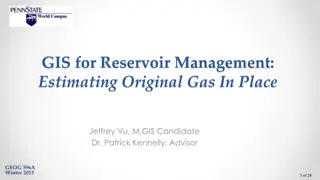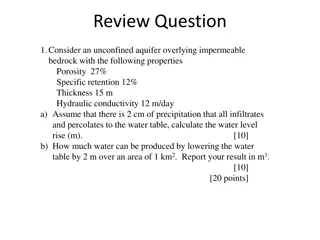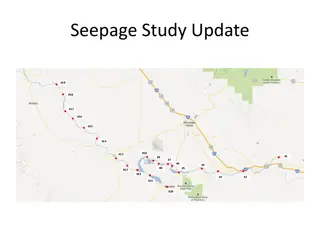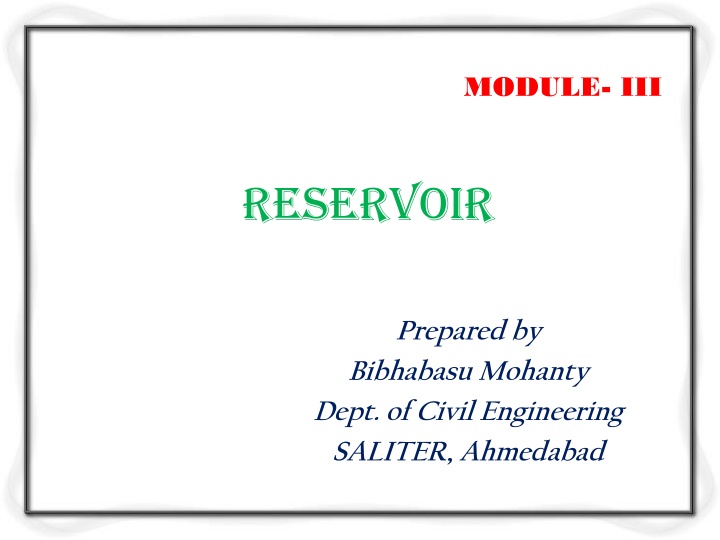
Reservoir Types and Purposes
A reservoir is an area developed by constructing a dam to store water for various purposes like irrigation, water supply, flood control, and more. There are different types of reservoirs such as storage, flood control, retarding, detention, distribution, multipurpose, and balancing reservoirs, each serving specific roles in water management.
Download Presentation

Please find below an Image/Link to download the presentation.
The content on the website is provided AS IS for your information and personal use only. It may not be sold, licensed, or shared on other websites without obtaining consent from the author. If you encounter any issues during the download, it is possible that the publisher has removed the file from their server.
You are allowed to download the files provided on this website for personal or commercial use, subject to the condition that they are used lawfully. All files are the property of their respective owners.
The content on the website is provided AS IS for your information and personal use only. It may not be sold, licensed, or shared on other websites without obtaining consent from the author.
E N D
Presentation Transcript
MODULE- III RESERVOIR Prepared by Bibhabasu Mohanty Dept. of Civil Engineering SALITER, Ahmedabad
Content Types, Investigations, Site selection, Zones of storage, Safe yield, Reservoir capacity, Reservoir sedimentation and control.
What is a Reservoir? It is an area developed by water body due to construction of dam. JungHua Dam (Taiwan) Tarbela Dam
Storage reservoir serve the following purpose : Irrigation Water supply Hydroelectric power generation Flood control Navigation Recreation Development of fish & wild life Soil conservation
Classification Storage conservation reservoirs because they are used to conserve water. Storage reservoirs are constructed to store the water in the rainy season and to release it later when the river flow is low Storage Reservoirs Reservoirs: : Storage reservoirs are also called Flood constructed for the purpose of flood control. It protects the areas lying on its downstream side from the damages due to flood. Flood Control Control Reservoirs Reservoirs: : A flood control reservoir is
Retarding Reservoirs: provided with spillways and sluiceways which are ungated. The retarding reservoir stores a portion of the flood when the flood is rising and releases it later when the flood is receding. Retarding Reservoirs: A retarding reservoir is Detention Reservoirs : excess water during floods and releases it after the flood. It is similar to a storage reservoir but is provided with large gated spillways and sluiceways to permit flexibility of operation. Detention Reservoirs : A detention reservoir stores
Distribution Reservoirs: small storage reservoir to tide over the peak demand of water for municipal water supply or irrigation. The distribution reservoir is helpful in permitting the pumps to work at a uniform rate. It stores water during the period of lean demand and supplies the same during the period of high demand. Distribution Reservoirs: A distribution reservoir is a Multipurpose Reservoirs: more than single purpose. Multipurpose Reservoirs: The are constructed for Balancing Reservoirs: reservoir constructed d/s of the main reservoir for holding water released from the main reservoir. Balancing Reservoirs: A balancing reservoir is a small
Investigations Engineering surveys Geological investigations Hydrological investigations
Engineering surveys Conducted for dam, reservoir and other associated work. Topographic survey of the area is carried out and the contour plan is prepared The horizontal control is usually provided by triangulation survey, and the vertical control by precise levelling.
Geological investigation Geological investigations of the dam and reservoir site are done for the following purposes. (i) Suitability of foundation for the dam. (ii) Watertightness of the reservoir basin (iii) Location of the quarry sites for the construction materials.
Hydrological investigations The hydrological investigations are conducted for the following purposes : (i) To study the runoff pattern and storage capacity. (ii) To determine the maximum discharge at the site.
Site selection Large storage capacity River valley should be narrow, length of dam to constructed is less. Watertightness of reservoir. Good hydrological conditions Deep reservoir
Small submerged area Low silt inflow No objectionable minerals Low cost of real estate Site easily accessible
Full (FRL) is the highest water level to which the water surface conditions. Full reservoir reservoir level level (FRL) (FRL): : The full reservoir level will rise during normal operating Maximum level is the maximum level to which the water surface will rise when the design flood passes over the spillway. Maximum water water level level (MWL) (MWL): : The maximum water Minimum lowest level up to which the water is withdrawn from the reservoir under ordinary conditions. Minimum pool pool level level: : The minimum pool level is the
Dead storage: minimum pool level is called the dead storage. It is provided to cater for the sediment deposition by the impounding sediment laid in water. Normally it is equivalent to volume of sediment expected to be deposited in the reservoir during the design life reservoir. Dead storage: The volume of water held below the Live/useful between the full reservoir level (FRL) and the minimum pool level is called the useful storage. It assures the supply of water for specific period to meet the demand. Live/useful storage storage: : The volume of water stored
Bank in the reservoir area and becomes available as seepage of water when water levels drops down. It increases the reservoir capacity over and above that given by elevation storage curves. Bank storage storage: : is developed in the voids of soil cover Valley natural river channel in its valley up to the top of its banks before the construction of a reservoir is called the valley storage. The valley storage depends upon the cross section of the river. Valley storage storage: : The volume of water held by the
Flood/Surcharge storage: between maximum reservoir level and full reservoir levels. It varies with spillway capacity of dam for given design flood. Flood/Surcharge storage: is storage contained
Safe yield Yield is the volume of water which can be withdrawn from a reservoir in a specified period of time. Safe yield is the maximum quantity of water which can be supplied from a reservoir in a specified period of time during a critical dry year.
Secondary available during the period of high flow in the rivers when the yield is more than the safe yield. Secondary yield yield: : is the quantity of water which is Average average of the firm yield and the secondary yield over a long period of time. Average yield yield: : The average yield is the arithmetic Design the design of a reservoir. The design yield is usually fixed after considering the urgency of the water needs and the amount of risk involved. Design yield yield: : The design yield is the yield adopted in
Reservoir capacity depends upon the inflow available and demand inflow in the river is always greater than the demand, there is no storage required if the inflow in the river is small but the demand is high, a large reservoir capacity is required
The required capacity for a reservoir can be determined by the following methods: 1. Graphical method, using mass curves. 2. Analytical method
Graphical method 1. Prepare a mass inflow curve from the flow hydrograph of the site for a number of consecutive years including the most critical years (or the driest years) when the discharge is low. 2. Prepare the mass demand curve corresponding to the given rate of demand. If the rate of demand is constant, the mass demand curve is a straight line. The scale of the mass demand curve should be the same as that of the mass inflow curve.
3. Draw the lines AB, FG, etc. such that (i) They are parallel to the mass demand curve, and (ii) They are tangential to the crests A, F, etc. of the mass curve. 4. Determine the vertical intercepts CD. HJ, etc. between the tangential lines and the mass inflow curve. These intercepts indicate the volumes by which the inflow volumes fall short of demand.
Assuming that the reservoir is full at point A, the inflow volume during the period AE is equal to ordinate DE and the demand is equal to ordinate CE. Thus the storage required is equal to the volume indicated by the intercept CD. 5. Determine the largest of the vertical intercepts found in Step (4). The largest vertical intercept represents the storage capacity required.
The following points should be noted. (i) The capacity obtained in the net storage capacity which must be available to meet the demand. The gross capacity of the reservoir will be more than the net storage capacity. It is obtained by adding the evaporation and seepage losses to the net storage capacity.
(ii) The tangential lines AB, FG; etc. when extended forward must intersect the curve. This is necessary for the reservoir to become full again, If these lines do not intersect the mass curve, the reservoir will not be filled again. However, very large reservoirs sometimes do not get refilled every year. In that case, they may become full after 2-3 years. (iii) The vertical distance such as FL between the successive tangents represents the volume of water spilled over the spillway of the dam.
Analytical method capacity of the reservoir is determined from the net inflow and demand. storage is required when the demand exceeds the net inflow. the total storage required is equal to the sum of the storage required during the various periods.
1. Collect the stream flow data at the reservoir site during the critical dry period. Generally, the monthly inflow rates are required. However, for very large reservoirs, the annual inflow rates may be used. 2. Ascertain the discharge to be released downstream to satisfy water rights or to honour the agreement between the states or the cities.
3. Determine the direct precipitation volume falling on the reservoir during the month. 4. Estimate the evaporation losses which would occur from the reservoir The panevaporation data are normally used for the estimation of evaporation losses during the month. 5. Ascertain the demand during various months.
6. Determine the adjusted inflow during different months as follows: Adjusted inflow = Stream inflow + Precipitation - Evaporation Downstream Discharge 7. Compute the storage capacity for each months. Storage required = Adjusted inflow Demand 8. Determine the total storage capacity of the reservoir by adding the storages required found in Step 7.
Determination of Yield of a Reservoir The yield from a reservoir of a given capacity can be determined by the use of the mass inflow curve 1. Prepare the mass inflow curve from the flow hydrograph of the river. 2. Draw tangents AB, FG, etc. at the crests A, F, etc. of the mass inflow curve in such a way that the maximum departure (intercept) of these tangents from the mass inflow curve is equal to the given reservoir capacity.
3. Measure the slopes of all the tangents drawn in Step 2. 4. Determine the slope of the flattest tangent. 5. Draw the mass demand curve from the slope of the flattest tangent (see insect). The yield is equal to the slope of this line
Reservoir Sedimentation is a difficult problem for which an economical solution has not yet been discovered, except by providing a dead storage to accommodate the deposits during the life of the dam. Disintegration, erosion, transportation, and sedimentation, are the different stages leading to silting of reservoir.
Causes of sedimentation Nature of soil in catchment area Topography of the catchment area Cultivation in catchment area Vegetation cover in catchment area Intensity of rainfall in catchment area
Sediment Management Maximum efforts should water should be released so that less sediments should retain in reservoir. Following options are: Catchment Vegetation Construction of coffer dams/low height barriers Flushing and desilting of sediments Low level outlets / sediment sluicing
Stepped watershed for sediment control

